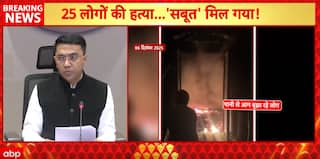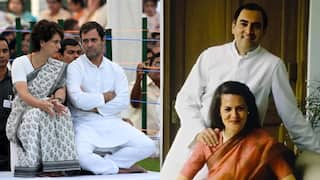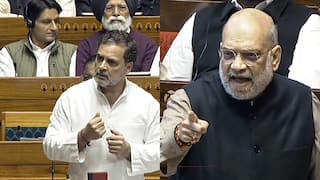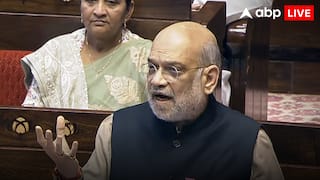Citadel Honey Bunny Review: Predictable & One-Toned! Are Raj & DK Tired Of The Genre?
If the American Citadel was more tech and style-heavy, and Italian: a performance-heavy version, the Indian version of 'Citadel' Honey Bunny is an interesting mix of Hollywoodian action and desi drama

Citadel Honey Bunny Review: Unlike the tech-heavy and superfluous action settings of the Priyanka Chopra and Richard Madden starrer American 'Citadel', the Indian version definitely feels more pragmatic. Raj & DK seem to have lost the touch somewhere with an international collaboration when it comes to their 'Citadel' spin-off starring Samantha Ruth Prabhu and Varun Dhawan, but atleast 'Honey Bunny' is worth watching.
'Citadel: Honey Bunny' may not be the best of Raj & DK but it gives some gravitas to the otherwise more-talk, less-show of the seriousness of independent spy agency Citadel's cause. And, this is best done with a relatable story, context and lead actors who nail it through guns, punches and chemistry that will set the Russo Brothers' franchise on the right track.
If the American Citadel was more tech and style-heavy, and Italian: a mature and performance-heavy version, the Indian version of 'Citadel' is an interesting mix of Hollywoodian action and desi drama, also deeply rooted in the changing dynamics of 90s Mumbai.
Plot & Setting
The setting is perfect. Samantha( Honey) and Varun ( Rahi aka Bunny) are a struggling actor and stuntman in Bollywood respectively, trying to make a name for themselves. Their professions are more of a foil to what they really are, agents to Baba( Kay Kay Menon) who works for the Foundation that is eager to destroy Citadel.
The destruction can be brought after Baba's men secure Armada, a tech that has the identities and data profiles of everyone in the world: a classic spy-genre device brutally overexploited in films and series of the genre( James Bond & Kingsman included).
Why Citadel: Honey Bunny does not work
Also Read: Samantha Was Injured During Citadel Honey Bunny Shoot: 'Nobody Took Me To The Hospital'
Too much talk
However, what does not land is the way Citadel and Manticore are text-book style inserted in the conversation. It was all well until Kay Kay Menon began preaching lessons on ideology and a back-story of two brothers sprung about, and the forecul connection between Citadel and Manticore was made.
In the first couple of episodes, too much spoon-feeding went into play. Flashbacks from episode 1 seep into episode 2 as 'explainers' and answers to 'who was there', 'why were they there', 'where is Nadia' etc. etc.
Undermining audience intelligence
As much as we value Raj & DK for their filmmaking style and their projected understanding of audiences' intelligence, this spoon-feeding exercise almost frustrated the viewing experience.
For all that we know, it is Rule No. 1 in the spy-genre thriller to not answer everything or even explain it. 'The Family Man' is a better example of how Raj & DK did it right.
Underdeveloped supporting cast
This also brings us to another big put-off in 'Honey Bunny'.
Despite an excellent choice of supporting cast, especially with Kay Kay Menon, Sikander Kher and Saqib Saleem, the makers do not sketch out their characters well. Despite earnest efforts by the cast, the flaws in the writing of their character trajectories show quite bluntly.
International collaboration
So, we get the money sanction for well-choreographed action sequences and the to and fro from territories, an A-lister cast, and all that an international collaboration with executive producers like Russo Brothers and a streaming giant like Prime Video can bring about, but why be people-pleasers?
At least, with 'Honey Bunny', it felt like the makers did try hard to tick all pointers in whatever checklist they were following to keep it intact, and in fact tone down the style they are so well-known for.
In that regard, 'Citadel: Honey Bunny' felt like a forceful connection being made with the American version. And that too with so much explaining of the principles of Citadel( organisation), the Foundation and Manticore.
This purposeful connection, in fact, brought down the organic chemistry and the plot that was leading up to the eventual climax of the series; thankfully Varun and Samantha's chemistry, Nadia's innocent yet far-beyond-her-years performance and some rooted-Bollywood drama saved it.
Where Citadel: Honey Bunny strikes points
Varun and Samantha's chemistry
It's not just the romance that's quite an X factor in the otherwise linear storyline of 'Honey Bunny' but also the way the two actors vibe in action-sequences that Varun and Samantha make the perfect team.
Varun Dhawan is more controlled in his web series debut and Samantha as this cold badass mother and an excellent spy are both good performers in the Raj & DK series.
However, not much well-rounded character frame is given to both leads as was established with all the promotional material before the series' premiere.
The so-many successful missions together, their camaraderie and how well they know each other or how strong their chemistry was just looming in the air and almost absent in the writing.
Perhaps, that aspect could be more developed in Season 2. For that regard, we will set the missing piece of the puzzle to rest until then.
Tech and action
'Citadel: Honey Bunny' is set in the 90s Mumbai. And, thankfully the setting helps Raj & DK not enter a tech-savvy territory they may not know or be well-acquainted with.
So, a clever ploy of the not-so-well-developed tech systems in Mumbai,unlike the American version of Citadel, becomes an added advantage which is infact compensated with the physically gruelling stunts the actors perform. Like Samantha says in a scene 'God did not give me height, so I compensated with strength', Raj & DK do the same with action when they did not have stylised tech in hand.
Interestingly, this compensation with excellent action choreography is a feather in their filmography, so well-executed that it even felt real to some degree.
Deeply rooted on home ground
One of the things that an international spy genre can do to most filmmakers is to give them wings to spread out to unknown and uncharted territories making the final product ( film or series) more vsually appealing but deeply shallow in context and depth of plot.
In that regard, Raj & DK hold on to home ground, use red-blue-brown colour palette, and aesthetise even the rough edges of Mumbai infrastructure and a dilapidated fort in Southern India to present an intersting mix of modern and fading architecture nexus to give a visually appealing, and yet a certain reality to their story that makes it believable.
Nevertheless, 'Citadel: Honey Bunny' is an interesting intervention in the international spy-genre series list. The series offers a distinctly cultural and international remix that borrows from the Indian style of filmmaking and Hollywoodian tropes.
Having said that, perhaps, the background music could also have been worked upon better.
Raj & DK's 'Farzi' and even 'The Family Man' had a better score and an opening credit sequence. In comparison to that, 'Citadel: Honey Bunny' felt quite bland.
There is a chance that a Season 2 works on these flaws to make an even better version of the Citadel series but this version is definitely better than the American one. For those who have not watched 'Citadel' American or Italian, 'Honey Bunny' can be a good start as it's only going to go downhill from there.







































